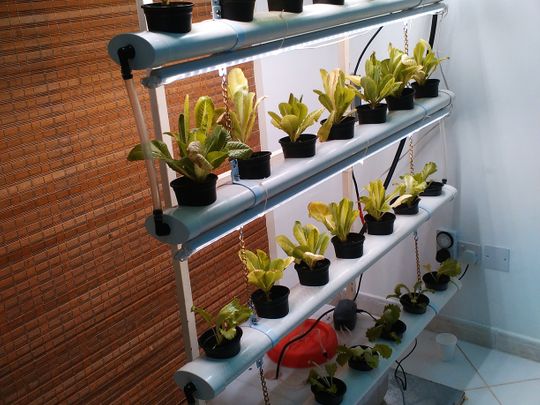A little under two years ago, Mariam Hareb Almheiri, UAE Minister of State for Food Security, made a presentation to the country’s leadership. The National Strategy for Food Security aims to take the UAE to top spot in the Global Food Security Index by 2021; enable sustainable food production through technological means; improve nutrition; and reduce waste. One of the technologies that can help turn this national strategy into reality is hydroponics.
Rethinking the food system
“I believe the current pandemic has provided us the opportunity to completely reimagine the global food system,” says Tony Hunter, a global food futurist. “Countries should look to ensuring domestic manufacture of basic foodstuffs for their own populations.” Hunter, who gave a talk on the potential silver linings of the pandemic for the global food industry in a Gulfood webinar earlier this year, believes hydroponics may be a promising method of ensuring a country can supply some of its own fresh produce at a time when Covid-19 has rendered international supply chains vulnerable.
Paresh Purushothaman, Managing Director at Greenoponics, says, “There is a lot of support in the local community for developing farms that use water-conserving methods such as hydroponics.” His company, which specialises in hydroponic and other soil-free agricultural technologies, serves both retail customers – primarily homes and offices – and commercial clients, who use slightly larger systems to grow their own produce.
Hydroponics at home
It’s easier than you think to set up a mini hydroponics system in your home – so long as you have a good grasp of its principles and a bit of patience, explains Purushothaman. “All you need is one free square metre to get started. A small system using a technology called deep water culture is the easiest way to start. You can grow leafy greens including basil, parsley, coriander, various varieties of spinach and rocket leaves.”
Greenoponics’ smallest system, Ezee, can grow all of these, and can fit 16 plants at once. Slightly more ambitious home gardeners can opt for the bigger Eva, which can grow up to 20 plants at once – including cucumbers and tomatoes – using a nutrient film technique. A staple for both salads and cooking, these fruits take about 35 to 40 days to mature, and one plant can provide multiple harvests.
New technologies
Meanwhile, The Sustainable City in Dubai is home to special controlled-environment domes that fuse fish farming and urban farming – a term referred to as aquaponics. “We have advocated urban farming since day one not only in response to the UAE’s food security strategy but also as a lifestyle,” explains Karim El-Jisr, Chief Sustainability Officer – Social. “Urban farming can assume many shapes and sizes, including aquaponics, which combines conventional aquaculture (better known as fish farming) with hydroponics (soilless farming).
“Whereas indoor farming tends to focus hydroponics for the production of leafy greens and vegetables, we wanted to explore aquaponics as a way to produce animal protein within a community. We currently operate an aquaponic system that produces fish and fodder such as alfalfa. Aquaponics is about nutrient cycling, whereby fish waste becomes a source of nutrients for the plants, which help maintain water quality for the fish,” he says.
El-Jisr says the pandemic has highlighted the need to prioritise local supply chains, and urban farming is simply a great opportunity to create value for society while protecting the environment. “Food security is about improving the availability of and access to healthy and essential foods, including fibre and protein. The benefits of urban farming, including hydroponics, is that we can produce a lot of food in small spaces, and save a lot of water.”
While he says hydroponics can increase yields over conventional farming by a factor of 12 while reducing per-crop unit of water consumption by up to 95 per cent, he does concede that one of the challenges of indoor farming is the energy requirements of recreating a plant’s natural environment.
Purushothaman points out to the increasing affordability of LED lighting and automation solutions as key to the medium-term growth of indoor farms. “Automation can set the release of nutrients and water circulation to a timer, while ensuring the oxygen content, PH levels and electrical conductivity of the water are at their optimal levels – all factors that determine a plant’s growth.”
Besides energy consumption, both El-Jisr and Hunter highlight the cost competitiveness of hydroponic produce – compared to conventionally farmed imported produce – as a key challenge to hydroponics becoming more mainstream. However, Hunter cites the lowering cost of technology as a means of redressing the balance, while El-Jisr says, “With time, through innovation, indoor farming will overcome these challenges.” With technology, believes Hunter, “Countries no longer need to be bound by the tyrannies of arable land and fresh water or be at the mercy of the agricultural and political policies of other countries.”


